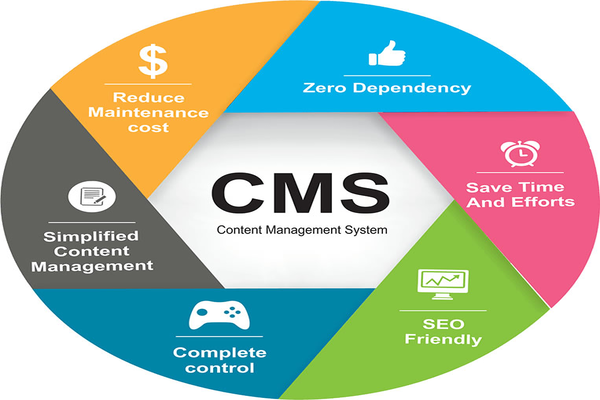
A Content Management System (CMS) Framework is used to build websites using different components in a short period and ensure easy management of its content. It helps facilitate the process of content delivery efficiently.
Many CMS frameworks also provide tools for the marketing and promotion of products and services to the target audience. Some of the top CMS are WordPress, Drupal, and Joomla.
If you wish to start your own website and add content to it, you have the option of either going for the CMS framework or using a web application framework. Some popular web application frameworks include Laravel, .NET, and Symfony.
Both CMS and web application frameworks come with their own set of pros and cons. In this article, you will learn about the pros and cons of using the CMS framework, along with tips on how to optimize the CMS workflow:
Pros of Using CMS Frameworks

Benefits of CMS
Quick Launching Time
The most significant benefit that CMS frameworks provide to users is the speed in the process of designing and launching the website. Most CMS comes with an easy-to-use dashboard or user panel.
They are fit for use by both beginners and advanced users. You don’t need to have any programming knowledge or technical skills. They won’t require you to hire experts in the field or spend a huge sum of money.
Design Options
CMS frameworks also come with a wide range of unique and eye-catching design options. Each CMS has its own unique style and approach to themes. You will find a rich set of built-in themes and even have the option to purchase premium themes. Many CMS also gives the freedom to users to customize or develop their own themes to fulfill the vision for their website.
If you want to perform modifications to the website efficiently and add a set of new features to make it more interesting, the CMS will provide you with plugin functionality to achieve this.
Plugins also provide simplification in the entire process of website design and building and enhance the experience for users successfully. In addition, it eliminates the need for in-line editing, and many of the components are easily reusable.
For example, you can find plugins for Joomla, like Redirect Link Cleaner, Spinner 360, and URL Canonical. Some Drupal plugins include Facebook Events Calendar, Drupal Testimonials Simple Block, and ValidShapes CAPTCHA.
Community Presence
Another main reason why many users prefer the top CMS frameworks is because of their strong community presence. It gives you an opportunity to get to meet skilled developers online, share your knowledge and increase your skills exponentially.
You come to know about the different tips and techniques involved in the design process, along with access to user-created modules, plugins, and features that can optimize your website user experience. In addition, you have the privilege of contributing to the community with your own unique modules and being recognized for your skill and expertise. Suppose you're looking to build advanced and highly interactive interfaces for your CMS-based projects. In that case, you can easily hire React developers from these vibrant communities who specialize in creating dynamic front-end solutions.
When a CMS has a strong community, the chances of its bugs and issues being fixed in a rapid manner are much higher. Whenever any issue is reported in the community, the developers immediately get to work on it and try to bring solutions. Many of these communities have been around for a long time.
SEO-Friendliness
Top-rated search engines like Google like to focus on on-page SEO factors, particularly the HTML elements when they are crawling the web pages of your business website. Therefore, they pay attention to factors like readable page URLs, title tags, meta descriptions, and headings.
They also pay attention to page speed, which depends on the coding quality and how fast the images load. You will also need to have redirects, canonical tags, robots.txt file, accelerated mobile pages, XML sitemap, and page caching.
Many framework CMS are created with the SEO needs of business owners in mind. Therefore, they typically offer some basic SEO features on the CMS and then provide you with the option to install and use plugins for additional SEO features. Some of the top-rated CMS for SEO purposes include Shopify, Drupal, WordPress, and Wix.
Benefits of using CMS
The Pros of Headless CMS
Developer-Friendliness
Headless CMS is gaining popularity for its developer-friendliness. It separates the place where the content is stored from where it is presented to visitors. It comes with an omnichannel architecture and creates boundaries between content editors and developers.
This allows the developers to make changes to the design of the website without clashing with the content editors. It offers tremendous freedom for experimentation. It also facilitates the distribution of content across multiple channels like apps, websites, the Internet of Things, TV, and wearables, among others.
Pick the right one for you CMS vs Frameworks
Cloud-Based
Headless CMS is typically cloud-based. Hence, it offers a high level of security and provides scope for creating a backup. In addition, it provides freedom in customization. Another significant benefit is that it helps users stay relevant despite rapid technological developments.
Hence, you will be saved from the effort of having to make time-consuming changes in the future. This allows you to direct more time and energy on important business functions.
You can check out this video to learn more about headless CMS
What is Headless CMS?
Cons of Using a CMS Framework
Safety Concerns
Security has been a long-standing issue for developers when they’re working on their apps or websites. Security threats can cause significant delays to the project, and when the website becomes vulnerable to risks, there is a huge chance of customers losing their faith and trust in the business.
It can also have an adverse impact on your SEO scores that can take a long time to repair. If you are using an open-source CMS, keep in mind that the source code will be available for everyone. Hence, it can make you vulnerable to different forms of attacks.
Plugin Dependency
Another major disadvantage of using CMS frameworks is that they often require you to install and use plugins to extend the functionality. Installing too many plugins can slow the performance down considerably.
Furthermore, many of the plugins require you to purchase to gain access to them. Hence, it can come with many hidden costs. Adding important features to your CMS without relying on plugins can be a time-consuming process as well. In many cases, you will be required to build your website from the beginning if you want to add more functionality.
Know more about Shopify CMS
CMS Requires Regular Maintenance
When you use a CMS, you will need to perform routine maintenance on a weekly basis, especially if you are a rapidly growing site that is attracting a huge number of visitors. You may require experts to perform the maintenance, which can be quite costly. In fact, plenty of paid CMS comes with a maintenance contract known as Tierce Maintenance Applicative (TMA).
If your website is not adequately maintained, your hosting company may become dissatisfied with the presence of your website on their server, and they will be compelled to shut down your website to protect the best interests of other website owners. This has now become a common practice among hosting companies.
Lack of Scalability
As your business grows in size, you may find that the CMS may not be able to accommodate your varied requirements anymore. In such a case, you will be required to make drastic changes to the CMS framework or make the jump to using web application frameworks, which can be a lengthy process, depending on your expertise and experience.
Limited Scope of Customization
When compared to the efficiency of web application frameworks, CMS offers a far more limited scope of customization. There will be certain limitations on the use of back-end functionalities and functional requirements. A web application framework, on the other hand, offers scope for customization in every aspect.
Slow Performance
Although many CMS are free-to-use and offer speed in the design process, a common complaint made by CMS users is that the webpages can often take time to load. This is one of the many reasons why many medium and large-sized businesses prefer the use of web application frameworks, as they offer much better performance and are more secure.
The Cons of Headless CMS
It Can Be Expensive
Headless CMS has expensive paid plans and will require you to pay for many different things. It will also charge you for the implementation process, as the content created will be delivered to multiple channels. It is best suited for businesses that wish to build complex or advanced websites with a rich user experience for a huge audience.
Not Suitable for Beginners
Headless CMS will typically have a steep learning curve. It is not particularly user-friendly and requires knowledge of programming along with other technical skills to get started. It is suitable for use by developer teams.
No Pre-Built Options to Choose From
Headless CMS doesn’t come with any pre-built themes or templates. It will be entirely up to the user to design and customize the website. It also comes with no preview option, so it requires tremendous expertise to make sure there is no presence of errors.
Hence, a headless CMS is only appropriate for people with experience in the field. If you make the jump from traditional CMS to headless CMS, you stand to lose all the functionalities, and it can take time to adjust.
You can look into this video to learn about headless CMS’s benefits and challenges.
Tips to Optimize Your CMS Workflow

Tips to optimize your CMS workflow
Chalk Up a Clear Plan
Before making a plan, the most important stage is to ponder over what exactly your goals and objectives are. The more clarity you have in this process, the better the outcome. You need to have a clear idea of what your average target audience member looks like. You will need to have a promising content and marketing strategy as well. You can talk to your audience and conduct surveys to understand their needs better.
Set Up Clearly Defined CMS Roles
The common CMS roles involved in the CMS workflow will be the content owner, project manager, content writers, graphic designers, editors, IT team members, and marketers, among others. Once these roles are assigned to the right people, you will then need to assign groups and permissions.
Have a Clear Project Timeline
The project must ideally be undertaken in different stages. Firstly, you will be required to talk to the stakeholders and understand what they precisely require. Then, the work of the content writers and editors will be given first priority.
After this, you can focus on ensuring a high-quality user experience. This will be followed by carefully reviewing your content and publishing it. After this, you will be involved in marketing and promotion efforts to ensure that it reaches your target audience. It is vital to avoid redundancy in the stages.
Also read: Know about CMS Framework PHP
Perform an Audit
Self-awareness in the proper implementation of the strategy is key. You will need to have a thorough knowledge or idea about your content ecosystem and take care of the nuances involved.
You will need to reflect on the dependencies involved in each aspect of the process. Your CMS workflow strategy must be capable of adapting to complex real-world changes and requirements.
Place Strong Emphasis on Standardization
There must be consistency and agreement among the team members in the CMS workflow. In order to achieve this, it is important to focus on the file naming conventions, approach to editing, file format standards, page layout requirements, and writing tone. You will also need to prepare checklists for things like SEO and metadata. By implementing this tip, you can be sure to save a lot of time and avoid unnecessary costs.
To Sum Up
Having an understanding of the various pros and cons of using a CMS framework puts you in a position of power. It will help you easily meet your deadlines and also ensure that quality is maintained.


